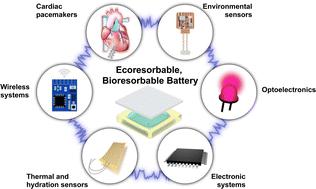当前位置:
X-MOL 学术
›
Energy Environ. Sci.
›
论文详情
Our official English website, www.x-mol.net, welcomes your
feedback! (Note: you will need to create a separate account there.)
High performance dual-electrolyte magnesium–iodine batteries that can harmlessly resorb in the environment or in the body
Energy & Environmental Science ( IF 32.4 ) Pub Date : 2022-09-05 , DOI: 10.1039/d2ee01966c Ivy Huang 1, 2, 3 , Yamin Zhang 1, 2 , Hany M. Arafa 1, 2, 4 , Shupeng Li 5 , Abraham Vazquez-Guardado 1, 2 , Wei Ouyang 1, 2 , Fei Liu 1, 2, 3 , Surabhi Madhvapathy 1, 2, 3 , Joseph Woojin Song 4 , Andreas Tzavelis 1, 2, 4 , Jacob Trueb 1, 2 , Yeonsik Choi 1, 2 , William J. Jeang 1, 2 , Viviane Forsberg 1, 2, 5 , Elizabeth Higbee-Dempsey 6 , Nayereh Ghoreishi-Haack 6 , Iwona Stepien 6 , Keith Bailey 7 , Shuling Han 8, 9 , Zheng Jenny Zhang 8, 9 , Cameron Good 1, 2 , Yonggang Huang 2, 3, 10, 11 , Amay J. Bandodkar 12 , John A. Rogers 1, 2, 3, 4, 10
Energy & Environmental Science ( IF 32.4 ) Pub Date : 2022-09-05 , DOI: 10.1039/d2ee01966c Ivy Huang 1, 2, 3 , Yamin Zhang 1, 2 , Hany M. Arafa 1, 2, 4 , Shupeng Li 5 , Abraham Vazquez-Guardado 1, 2 , Wei Ouyang 1, 2 , Fei Liu 1, 2, 3 , Surabhi Madhvapathy 1, 2, 3 , Joseph Woojin Song 4 , Andreas Tzavelis 1, 2, 4 , Jacob Trueb 1, 2 , Yeonsik Choi 1, 2 , William J. Jeang 1, 2 , Viviane Forsberg 1, 2, 5 , Elizabeth Higbee-Dempsey 6 , Nayereh Ghoreishi-Haack 6 , Iwona Stepien 6 , Keith Bailey 7 , Shuling Han 8, 9 , Zheng Jenny Zhang 8, 9 , Cameron Good 1, 2 , Yonggang Huang 2, 3, 10, 11 , Amay J. Bandodkar 12 , John A. Rogers 1, 2, 3, 4, 10
Affiliation

|
Batteries represent the dominant means for storing electrical energy, but many battery chemistries create waste streams that are difficult to manage, and most possess toxic components that limit their use in biomedical applications. Batteries constructed from materials capable of complete, harmless resorption into the environment or into living organisms after a desired period of operation bypass these disadvantages. However, previously reported eco/bioresorbable batteries offer low operating voltages and modest energy densities. Here, we introduce a magnesium–iodine chemistry and dual (ionic liquid/aqueous) electrolyte to overcome these limitations, enabling significant improvements in voltage, areal capacity, areal energy, areal power, volumetric energy, and volumetric power densities over any alternative. Systematic studies reveal key materials and design considerations. Demonstrations of this technology include power supplies for cardiac pacemakers, wireless environmental monitors, and thermal sensors/actuators. These results suggest strong potential for applications where commercial battery alternatives pose risks to the environment or the human body.
中文翻译:

高性能双电解质镁碘电池,可在环境或体内无害地再吸收
电池代表了储存电能的主要方式,但许多电池化学物质会产生难以管理的废物流,并且大多数含有限制其在生物医学应用中使用的有毒成分。由能够在期望的运行时间后完全、无害地再吸收到环境或活的有机体中的材料构成的电池绕过了这些缺点。然而,先前报道的生态/生物可吸收电池提供低工作电压和适中的能量密度。在这里,我们引入了镁-碘化学和双(离子液体/水)电解质来克服这些限制,与任何替代方案相比,能够显着提高电压、面积容量、面积能量、面积功率、体积能量和体积功率密度。系统研究揭示了关键材料和设计考虑因素。该技术的演示包括用于心脏起搏器、无线环境监测器和热传感器/执行器的电源。这些结果表明,商业电池替代品对环境或人体构成风险的应用具有很大的潜力。
更新日期:2022-09-07
中文翻译:

高性能双电解质镁碘电池,可在环境或体内无害地再吸收
电池代表了储存电能的主要方式,但许多电池化学物质会产生难以管理的废物流,并且大多数含有限制其在生物医学应用中使用的有毒成分。由能够在期望的运行时间后完全、无害地再吸收到环境或活的有机体中的材料构成的电池绕过了这些缺点。然而,先前报道的生态/生物可吸收电池提供低工作电压和适中的能量密度。在这里,我们引入了镁-碘化学和双(离子液体/水)电解质来克服这些限制,与任何替代方案相比,能够显着提高电压、面积容量、面积能量、面积功率、体积能量和体积功率密度。系统研究揭示了关键材料和设计考虑因素。该技术的演示包括用于心脏起搏器、无线环境监测器和热传感器/执行器的电源。这些结果表明,商业电池替代品对环境或人体构成风险的应用具有很大的潜力。











































 京公网安备 11010802027423号
京公网安备 11010802027423号